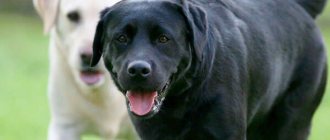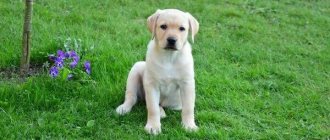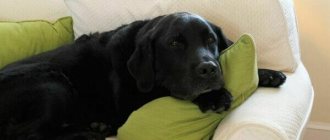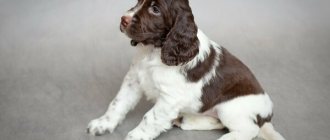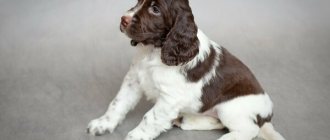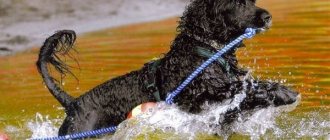Labradors are sociable, intelligent dogs that prefer active, long walks. They have retained their hunting habits; they are excellent at searching for shot game on land and in water. To maintain the health of the pet, the owner will have to take care not only of its balanced diet and walks. But also about preventive vaccinations that can protect a puppy and an adult animal from viral infectious diseases.
Outdoor content
Labradors are a domestic breed, and it is highly undesirable for them to constantly live outside.
This especially applies to puppies, who are sociable and affectionate creatures. Labradors living in a private home are the luckiest of all, because they are provided not only with cozy housing, but also with an excellent playground. As in the apartment, an enclosure for the dog is being built in the yard, in which the place of the bed should be taken by a full-fledged kennel on an elevated island. A Labrador's kennel must be large and strong so that the dog can fit in it completely and comfortably. Standard kennel sizes for this breed are 110 cm in length, 90 cm in width and 80 cm in height.
In addition to the booth, there should be a feeding area with bowls filled with fresh water and food, a canopy that creates shade, and toys. When letting the puppy out of the enclosure, make sure that he does not come across trash in the yard or food waste. In addition, Labradors are capable of digging, so the fence and walls of the enclosure must be strong.
Labrador personality
Labradors are rightfully called universal dogs. This breed has no aggression at the genetic level; Labradors are obedient, loyal and good-natured, but at the same time quite fearless: this dog is very difficult to scare.
Labrador Retriever: Walking each other.
Labrador Retriever: puppy look.
Labradors are smart and insightful, have a stable psyche, understand a person at a glance, and feel great in any environment. Therefore, they are ideal for both a large family and a single owner.
Labradors, originally intended for hunting and heavy physical activity, do not tolerate a sedentary lifestyle, so the pet needs regular walks with active games and bathing.
A born fetcher, the Labrador, with the best of intentions, will try to bring everything to its owner, so it is necessary to raise a dog and teach it to the “fetch” command from early childhood.
A Labrador Retriever puppy is taught to hunt.
The lifespan of a Labrador is between 13 and 15 years.
The dog breed, which is incredibly popular in all countries, is considered universal, as it has many talents. The Labrador Retriever dog is an indispensable companion of rescuers; he is among the first to arrive at the scene of disasters to look for people under the rubble. There are many Labradors serving in the police, airports and railway stations, performing search functions. The natural friendliness of this breed allows them to be used as guide dogs, but initially these dogs were used as game hunters.
The Labrador Retriever is a fairly ancient breed of dog that lived on the island of Newfoundland. Smart, large dogs loved water, could dive and swam well, often rescuing children and careless adults who had fallen into the sea. Cheerful and kind dogs willingly played with children and learned quickly. In addition, Labradors were used by local residents as hunting dogs, who brought game from hard-to-reach places, thickets or from water.
The sailors who arrived on the island were surprised by the abilities of the local dogs and willingly purchased them for service at sea. Sea travel was not at all depressing for the dexterous dogs, who had waterproof fur, because ice flakes did not stick to it, and a specially shaped tail, with which they maneuvered through the waves. Labradors (translated from Portuguese as a worker) brought caught fish from the water and tackle that had fallen into the sea or cables and other equipment washed away by the waves.
Dogs came to Britain at the beginning of the nineteenth century. Local residents were happy to acquire smart and friendly dogs that got along with animals, loved children and did not attack poultry. The character of Labradors did not have the aggression and malice inherent in terriers, so they quickly became popular not only among sailors, but also among farmers and townspeople.
It took the breed less than a hundred years to be recognized by the English Kennel Club. In 1903, it received official recognition and the Labrador Retriever standard was approved. According to him, only black representatives of the breed were allowed for breeding, although initially the breed had fawn, chocolate and black colors. Much later, decades later, the standard was slightly changed, and all three colors were officially recognized.
England is considered not only the ancestor of the Labrador breed, but also became the first country where, in the seventies, there was a clear division into working and show dogs. Field dogs had a drier type of constitution; they had light bones and an elongated muzzle. Exhibition or show dogs were rawer, heavier, with large heads and shortened muzzles.
Currently, the division into show and working Labradors is still visible, but the trend towards heavier bones is gradually fading away. In the rings, dogs with a strong build with a proportional head and a hard coat inherent to the breed are increasingly winning.
Briefly about the breed
Labradors stand out for their massiveness and proportionality. On average, dogs of this breed reach a height of at least 50 cm and a weight of more than 20 kg.
Their body is powerful and long with a voluminous chest and a wide head. The drooping ears are located slightly back, almost on the back of the head, and the almond-shaped eyes are set far back, which visually narrows the elongated muzzle.
The tail, thick at the base, gradually tapers and is almost always in a horizontal position.
Such a hard, dense and short coat was inherited from their ancestors living on the cold shores of Canada, and thanks to the well-developed undercoat, it reliably protects them from low temperatures.
Before getting a large pet, you should consider having a large empty space.
Numerous photographs of dogs show that Labradors prefer freedom of action, and better yet, constant exposure to nature.
Features of the first days of life
Preparation for proper puppy care should begin even before the baby arrives.
- Decide in advance where the pet will be located in the house. There should be no drafts, sharp corners or crevices nearby where the pet can crawl.
- Put away small items, jewelry, and medications that your baby might swallow.
- If the house has laminate or parquet, it is advisable to cover the floor with a carpet or runner at first.
- Immediately buy everything you need to care for your little Labrador: vitamins, food, brushes, toys, dishes, a collar with a leash, etc.
Like all puppies, Labradors are born blind, helpless, unable to independently regulate their body temperature and eliminate waste products.
Important! At these times, their mother is completely responsible for the life of the baby: she not only feeds, but also warms, and also stimulates the work of the small intestines with her caresses. Learn how to care for Dachshund, Chihuahua, and German Shepherd puppies.
At what age are puppies vaccinated for the first time?
Dog breeders plan to give their puppies their first vaccination at two months of age. They provide detailed information to future owners about the vaccinations given, the timing of their repetition, the pet’s behavioral reactions after the procedure, and hand over a veterinary passport.
An earlier introduction of the vaccine is not advisable, since the baby still has “maternal” immunity, which will perceive the antibodies from the vaccine as a full-fledged threat, which will negate the results of immunization.
Vaccination schedule and which ones should be done
To raise a healthy Labrador and avoid frequent visits to the veterinarian, it is necessary to vaccinate the animal against all kinds of diseases on time.
Mandatory vaccinations for a Labrador in the first year of life:
- plague of carnivores (distemper);
- parvovirus enteritis;
- parainfluenza;
- rabies;
- infectious hepatitis;
- leptospirosis;
- trichophytosis;
- microsporia.
The first vaccination against plague is given to an animal at 2 months of age. The vaccination is quite difficult to tolerate: with fever, general weakness and diarrhea. The second vaccination (also against plague) is administered after 3 weeks. This time the Labrador should feel lighter.
At 2.5-3 months, it is necessary to vaccinate the animal comprehensively (one vaccine includes drugs against several diseases at once).
At 4 months of age, the puppy is vaccinated against rabies and the complex vaccine against a group of diseases is repeated. If your baby's teeth change during this period, you should wait. In this case, all vaccinations are given to the Labrador at 5 months.
Popular articles Drug Ligfol: an effective immunity corrector for cats
At 1 year of age, the dog is revaccinated against distemper, rabies and other unpleasant and dangerous diseases with a complex vaccination. These vaccinations must be repeated every year.
Why vaccinate your Labrador puppy?
Infectious diseases are the most common problem in dogs. Germs, viruses and fungi affect even healthy pets. Some infections are highly contagious. It only takes a few microbial particles to cause disease. In this case, direct contact between the pet and the sick dog is not necessary.
Many infectious diseases are very difficult to treat and take a long time, so vaccination is necessary.
Most infections are transmitted through excrement residues or saliva particles. Many of the diseases are treated very difficultly and for a long time, some are not treated at all. Therefore, it is imperative to vaccinate an adult dog and a Labrador puppy, even if the dog does not leave the enclosure or garden.
Master's Code
A loyal friend, companion, assistant - that's all he is, a Labrador; caring for and keeping a representative of the breed at home can seem quite complicated. This is an active dog that needs to run around and splash out its energy. In addition, due to its considerable size, it consumes quite a lot of feed.
Labrador is an excellent companion and faithful friend for many years
For your information! Those owners who decide to stick to natural food will have to cook especially for the dog, and in large portions.
Before you make the final decision to become a Labrador Retriever owner, you should familiarize yourself with the following owner code:
There are no bad dogs. There are unscrupulous and irresponsible owners; The standard life expectancy of dogs is 12-18 years. All this time he will need to be taken care of, walked every day, regardless of the weather and health; an animal is not a toy that you can get rid of if you decide you’re tired of it
This is a living creature with its own character and habits; it's important to be consistent. The cute antics of a puppy who loves to affectionately bite his owner’s legs will no longer be so touching as he grows up.
Therefore, from early childhood, all prohibitions are practiced clearly. If you can’t, then you can’t forever; training and training should be carried out according to the principle from simple to complex. A “carrot and stick” policy without physical violence and aggression is the choice of a responsible owner. “Whip” in this case is a stern tone, a demonstration of displeasure; The dog's nutrition is the responsibility of the owner. A dog is not a pig, waste from the human table is not suitable. They either prepare it separately or buy ready-made industrial feed; The veterinarian is a specialist whom you will have to get to know. Preventive examinations should become a good habit. It is better to prevent any disease than to treat it.
These are the main points that a Labrador owner should consider.
The Labrador will become a true friend to its owner, but needs proper training
Vaccinations for Labradors: strictly as prescribed by the doctor
The veterinarian will perform an examination and create a vaccination schedule for the dog. Deviations from the standard vaccination schedule are possible only for valid reasons. For example, due to an epidemic in your area. In this case, the doctor may decide to postpone the procedure.
Therefore, the information in the article about what vaccinations Labradors need is purely for informational purposes. We will tell you at what age a Labrador receives its first vaccination. How does a puppy tolerate vaccinations? And also what drugs exist and what is the price of the vaccine.
Photo. Puppy vaccination begins with measuring the temperature.
Basic rules for caring for a puppy
Caring for a Labrador puppy requires the owner to have certain knowledge and skills. Bathing an animal, combing its fur, brushing its teeth and ears, and trimming its claws - you need to learn all this and try to carry out the necessary manipulations patiently and conscientiously.
Your pet should be accustomed to hygiene procedures while it is small, otherwise problems may arise later.
Cleaning teeth and ears
Cleaning a dog's teeth and ears should become a habit for both owner and pet. The health and well-being of your Labrador depends on the regularity of these procedures. Before starting the procedure, you must carefully examine the animal's ears and teeth for infections, wounds or inflammation.
For ear hygiene, use a cotton pad soaked in a special lotion for cleaning the ears. You should pull the animal's ear back and gently wipe its surface from the inside. Lotions dissolve earwax very well.
Do not use alcohol- or oil-containing liquids. It is not recommended to use cotton swabs or tweezers wrapped in gauze to clean your ears. The skin inside the ears is thin and delicate, and it is very easy to damage it.
Your pet's teeth also need regular care. The procedure is carried out with a special dental product purchased at a pet store. You can brush your dog's teeth with your finger wrapped in a bandage or with a dog tooth brush.
These hygiene measures should be carried out at least once a week.
When teeth change
At 3 months old, a healthy Labrador puppy looks like a completely happy, restless and cheerful animal. The only thing that can interfere with him during this period of life is changing teeth.
A Labrador's teeth change between the ages of 3–3.5 and 9 months. The milky ones are replaced by permanent ones.
The process of changing teeth takes place in the following order:
- at about 3 months the primary incisors change;
- from 4 to 5 months, premolar teeth grow;
- At 6 months, a Labrador retriever's fangs fall out and molars—molars—appear;
- Usually at 9 months the animal should have 42 teeth - a full set of adult pets.
During this period, it is necessary to inspect the dog’s mouth more often (2-3 times a week)
If a baby tooth is very loose, you can pull it out by carefully grasping it with two fingers
When the process of replacing teeth is very late, it is worth contacting a veterinarian. Timely replacement of teeth in a Labrador affects the correct formation of the bite and jaws.
In large breeds of dogs, the process of replacing teeth goes smoothly. However, during this difficult period you should refrain from vaccinations and feed your dog properly.
Nail trimming
Nail trimming is carried out with special forceps - a nail clipper. This is done very carefully so as not to damage the paw pads and not to cut the claw very deeply. It is better if someone holds the puppy while doing this.
Carefully taking the dog's paw in your hand and spreading the fingers, you need to cut off the ends of the claws parallel to the pads. Then, when the pet gets used to the procedure, it will be possible to do without outside help
Grooming
Caring for the coat of a small Labrador is not difficult at all, as it is smooth and short. It is enough to brush your pet 2-3 times a week with a dog brush. To prevent your pet from developing dandruff, you can wash it with a special shampoo. However, you should not bathe your dog very often - once every one and a half to two months is quite enough.
During the bathing process, you need to make sure that water and shampoo do not get into the eyes, ears or mouth of the animal. Labradors are usually not averse to swimming and playing in a pond, but not all dogs like swimming.
How to care for Labrador puppies at the age of 1 month? A similar problem can arise if for some reason the mother dog is not around. First of all, you need to monitor the body temperature of small puppies. Normally, it should be no lower than 35 degrees. Puppies should eat every hour and a half.
It is advisable that the mother feeds them herself. It is necessary to monitor the baby's weight gain. If there is a shortage, you need to start feeding them.
Consequences of puppy vaccination
After vaccination, the dog may not feel very well. A violent immune reaction occurs in the puppy’s body - antibodies are formed. And the more infections a vaccine protects against, the more active the production of antibodies will be.
After vaccination, the puppy may not feel very well, but this is a normal reaction to the administration of the drug.
After vaccination, the following may occur:
- The puppy may be lethargic and drowsy and refuse to eat for a couple of days.
- A one-time bowel disorder should not cause you to worry.
- Body temperature may rise.
Swelling sometimes appears locally at the injection point. As a rule, this is simply a thickening associated with the administration of the drug.
If these reactions go away within a few days and do not significantly worsen the puppy’s well-being, then you should not pay attention.
Important! If the puppy is very weak, vomiting, refuses food and water for more than 12 hours in a row, or there is large swelling at the injection site, you should contact a veterinarian urgently.
Three colors of Labrador
According to the standard, Labradors come in three colors:
- Black;
- Chocolate;
- Fawn.
Black coloring is considered traditional and is complemented by brown or hazel eyes and dark earlobes. A dog with such fur shines and shimmers in the sun. The blackness can be diluted with a white spot on the chest or tan marks.
The “boom” of dogs with brown fur has not yet passed, and more and more people want to have such a spectacular pet.
The combination of chocolate color with hazel or yellow eyes is also interesting. However, “rich” chocolate must be properly cared for: do not keep dogs in the sun for long and feed it with special vitamins.
Labradors with fawn coats come with golden, light cream, red tint or brown pigmentation.
Nothing terrible happens
When talking about mating, it is definitely worth explaining such a physiological phenomenon as a “lock”. Dogs enter this state in the final stage. Outwardly, everything looks quite strange. They stand with their backs pressed against each other. For ignorant people, it may seem that something terrible has happened - the poor animals cannot disentangle themselves and are stuck to each other. In fact, everything is understandable.
The fact is that during intercourse, the bulb of the genital organ (head) of a male dog increases significantly in size. At the same time, it is tightly clamped by the muscles of the bitch’s vagina. This is how a “lock” or state of gluing is obtained. The male can free himself only after the head reaches its normal size and the vaginal muscles relax. This takes 10-15 minutes, and sometimes more. This is how nature took care of creating conditions for fertilization during mating.
At this time, the dogs should not be disturbed; they should be given the opportunity to complete the process.
By the way, mating is also observed in other dog-like animals - wolves, hyenas, jackals.
Possible consequences after injection
For several days after the injection is given, the puppy may feel unwell. The following manifestations are possible:
- temperature increase;
- one-time stool disorder;
- refusal to eat for 2 days;
- lethargy, drowsiness.
- swelling or hardening at the injection site.
The listed symptoms are considered mild, they do not affect the vital processes in the body, and go away on their own in 2–3 days. They are a consequence of the introduction of viruses, the rapid activity of the defense system and its reaction to antigens.
In case of severe manifestations: vomiting, refusal of water or food for 12 hours or more, severe weakness, swelling of the injection site, the pet is urgently taken to a veterinarian for examination.
Hygiene
There is an opinion that large breed dogs have a characteristic odor, but this only happens when the owner does not pay enough attention to the pet’s hygiene. In order for a Labrador living in an apartment to be well-groomed, you need to regularly comb the pet’s fur, bathe it when it gets dirty, trim its nails and clean its ears.
If your Labrador exhibits lethargy, upset bowel movements, vomiting, skin rash, inflammation and suppuration of the eyes (ears) and other abnormalities, you should immediately show the dog to the veterinarian!
Popular articles Cats: description of all breeds
Why are puppies vaccinated?
It is a mistake to think that you can only catch a disease through contact with a sick dog. Viruses are common in animal walking areas, training grounds, forested areas, and are found in excrement, particles of saliva, and on the owner’s shoes. Labrador puppies love to chew (including their shoes), so they are more likely to get infected.
Timely vaccination will protect him from infectious hepatitis, leptospirosis, canine distemper, parainfluenza, rabies, and parvovirus enteritis. With the help of vaccination, the pet will be injected with weakened particles of one or more viruses, in response to which the dog’s body will begin to produce antibodies, forming lasting immunity to the received antigens.
Nutrition
The basis of the diet of an adult representative of the breed is food rich in amino acids, complex carbohydrates and proteins. Such substances are present in cereals, meat and dairy products. In addition, a Labrador puppy should receive microelements contained in fruits, as well as vitamins found in vegetables. He will gain weight gradually. Let's consider a daily menu option for a baby retriever:
- Boiled cow's milk + 100 grams of raw chicken.
- Buckwheat with milk or cottage cheese.
- Boiled or steamed vegetables, such as peppers, broccoli and carrots.
- 100 grams of raw meat.
- Fruits, for example banana.
Cereals can be replaced with soup or broth. Gradually, the amount of food for the dog needs to be increased. This is required for the gradual growth of bones and muscles. An adult representative of the breed can be switched to premium dry food.
Their use of this product has a number of advantages. Firstly, the animal that consumes it will definitely be well-fed and healthy. Secondly, you won't have to cook for it often (trust me, you'll save a lot of time).
In addition, do not forget to treat your dog with berries. She really loves melon, watermelon or raspberries. Never give her spicy fish or chicken bones! They can get stuck in the animal's throat and even lead to its death. Also limit his consumption of processed meats, fatty and fried foods, and smoked foods.
Golden Retriever or Labrador Retriever: Which One to Choose?
The differences between two related breeds, the Labrador Retriever and the Golden Retriever, can be summarized in a few sentences:
- The Labrador is a simple-minded and familiar dog
, with a certain importunity and an absolutely and charmingly careless attitude towards family members. He can, rushing towards the owner, drop a small child or run over him without even turning around to cry. Noisy and very active, the Labrador loves to eat and is prone to imposing its desires on people. Dogs of this breed are simple village boys, strong and courageous, but do not have a subtle understanding of human feelings. - The Golden Retriever is a sophisticated and elegant aristocrat
, calmer, more balanced. A dog of this breed, in addition to long and beautiful hair, has a certain intuitive understanding of the owner’s mood.
Training from 6 months
At this age, the puppy begins puberty and the real rebel awakens in him. He begins to re-test the boundaries of what is permitted and, sometimes, deliberately does not respond to your commands, only in order to look at your reaction. If she is not what the puppy expects to see, then he may decide that now he can no longer carry out your commands.
At this stage of the Labrador puppy's growing up in training, all the shortcomings made at the previous stages, which were smoothed out by his young age, become clearly visible. And if they appear, it’s time to correct them.
In many training schools, there is an opinion that a puppy needs to be trained in two stages, the first at an early age, and the second at 8 - 10 months, in order to “consolidate” what has been learned. This is not an entirely correct position; this opinion appeared when newer operant training methods began to be added to the old “DOSAAF” rigid training methods, where they began to work with the puppy strictly after 6-7 months, including working with the method of pointing and following the “target”.
Their weakness was that they were two different techniques.
, which began to be used without adapting to each other, having a huge gap between their tools for developing training skills. The difference between them is like between choreography lessons in kindergarten and army drill training. Therefore, they required training in two stages, which were in no way connected with each other.
What vaccinations should a puppy have?
The veterinarian at the clinic will tell you what vaccination options are available. The vaccination schedule may vary slightly depending on which vaccine the puppy's owner chooses. Before visiting the veterinarian, the owner can familiarize himself with the possible vaccination options.
There are several different types of vaccines, and your veterinarian can help you choose.
Eurican
This is a vaccine made in France. It protects against plague, adenovirus and parainfluenza virus of the second type, parvovirus, leptospirosis, and rabies. These are the most common and dangerous diseases that a Labrador can suffer from.
The vaccine itself consists of two components. Before use, the contents of both bottles are mixed. This ready-made vaccine cannot be stored - it should be immediately administered subcutaneously. The vaccination volume is only 1 ml - for a fairly large Labrador, vaccinations are usually painless.
Duramune
This vaccine is produced in the United States of America, which guarantees a very good quality of vaccination. This drug will protect your Labrador from a large number of infections. A bottle of dry powder vaccinates against canine distemper, parvovirus, adenovirus, and parainfluenza. The liquid component will provide protection against leptospirosis and coronavirus.
This Duramun vaccine can be used in a dog that is nursing puppies. Before use, both bottles are mixed. Regardless of the age and size of the pet, 1 ml of vaccination is administered subcutaneously.
Vangurad
This vaccine, like the previous one, is manufactured in the USA. The fundamental difference is that Vanguard does not protect against coronavirus infection, immunity from which is provided by the liquid component of the Duramun vaccine.
The Vangurad vaccine is produced in the USA and protects your pet from major infectious diseases.
However, Vanguard reliably protects against all other microorganisms: adenovirus, parvovirus, parainfluenza, leptospirosis and distemper. The vaccine is also available in the form of a dry and liquid component. This packaging allows the vaccine to be stored for a long time. The drug is prepared immediately before administration. 1 ml can be injected subcutaneously starting from 8-week-old puppies.
Nobivac
The Nobivak complex vaccine protects Labrador Retrievers from plague, infectious hepatitis, parvovirus and parainfluenza. The vaccine is produced in the Netherlands. The list of infections against which Nobivak guarantees immunity is shorter than that of previous vaccines. But Nobivak compensates for this with easier tolerability and reliable protection against the most common diseases.
The vaccine looks like a dry powder in a vial. It is packaged in packages along with a special solvent and prepared immediately before administration. 1 ml of the drug is injected under the skin if the puppy is healthy, treated for helminths and has reached 8 weeks of age.
Dangerous insects
After each walk, you need to inspect your pet's fur for ticks. By brushing your dog, you will remove not only loose hair, but also some of the attached insects. Ticks that have already sucked will fall off on their own. And those that hold tightly must be carefully removed.
Lubricate the tick with vegetable oil to limit its access to air. After 15-20 minutes it should fall off on its own. If this does not happen, then use tweezers or thread to pry the tick and begin to twist it out. Be careful that the insect's head does not remain in the skin. If you are not confident in your abilities, it is better to consult a doctor.
The presence of fleas in an animal is very easy to determine. Black crumbs (products of their vital activity) appear in the wool. And on the stomach, in the armpits or on the inside of the hind legs you can find bite marks in the form of red spots. Special sprays, powders, drops that can be found at the pharmacy will help get rid of fleas. Among domestic ones, these can be “Bars” or “BlochNet”, among imported and more expensive ones - “Frontline” or Hartz. It is necessary to treat not only the dog’s fur, but also the room where it lives, especially the kennel and rug.
How to care for a puppy
Anyone who has ever dealt with dogs knows how to care for a Labrador puppy. This process is simple, you just need to adhere to a number of rules that relate to the living conditions and health of the baby.
Air temperature and humidity
The main source of heat for puppies is the mother's body, so it is important to ensure that the room temperature is high enough. For newborns, it is advisable to maintain it at a level of +24...+26 °C, and closer to the bed itself - and all +29 °C
With each week the puppy grows up, the temperature should be lowered by 2-3 degrees. At the age of 4 weeks, babies are ready to calmly tolerate normal room temperature.
Did you know? Labradors are excellent swimmers, thanks to their unique webbed paws.
Also included in the retriever group are the following dog breeds: cocker spaniel, hairy labrador, labrador and golden retriever.
Cleanliness and hygiene
Caring for and raising a Labrador puppy necessarily includes taking care of the baby’s hygiene. To ensure that your dog is always well-groomed and clean, you must:
- brush his fur every day (buy a soft brush for this, the baby will love this massage);
- bathe periodically as needed;
- Wipe your eyes with cotton wool every day. If tearing or inflammation is noticeable, you should seek help from a doctor;
- monitor the claws of the babies and trim them in a timely manner, otherwise the babies may injure the mother;
- Lubricate his paws with wax-based ointment before a walk so that the delicate pads do not get hurt, and when returning home, wipe them with a damp cloth or napkin.
Important! If your baby manages to get dirty while out for a walk, don’t rush to bathe him. In this case, it is better to use wet wipes to remove dirt.
Baby's health
Labradors are famous for their good health, so the owner only needs to ensure that external factors do not harm his pet. The main signs of health problems in your baby are:
- lack of appetite;
- low temperature;
- no weight gain;
- squeak and cry of the baby;
- diarrhea.
The last symptom can occur for two reasons:
when switching to complementary foods. Due to hormonal changes in the baby’s body, its microflora is disrupted. The puppy's excrement changes only its consistency, but not its color or smell. To improve the situation, you need to give your baby probiotics, which can be purchased at any veterinary pharmacy; when contracting an infection
In this case, it is important to promptly seek help from a specialist, otherwise a fragile immune system may not be able to cope with the load.
Did you know?
Labradors have larger scent chambers than other dogs, so they have a better sense of scents.
That is why this breed was used in cancer detection experiments. Labradors have proven that they can determine by the smell of a person’s urine whether he has cancer or not. Caring for dogs is very important, so take care of how to properly trim nails, make a pattern for overalls, choose a toy, clipper, collar, furminator, and learn what trimming and grooming are. Before vaccination, make sure that:
- the puppy is healthy;
- at least 10 days have passed since the last deworming;
- Over the past three days, the baby's temperature has been within normal limits.
Important! It is mandatory to get vaccinated against rabies every year.
Attention and love
Labrador is a positive breed that needs affection and attention from its owner, as if in the air. You need to pet him regularly and talk to him, otherwise the baby will get upset. First of all, give the puppy a name. Typically, Labradors get used to their name in 2-3 days and respond to it very quickly. One of the manifestations of love for kids will be walking together. You can start with 10-15 minute walks twice a day, but a couple of times a week make forays into parks or vacant lots where the puppy can run around without a leash.
Popular articles Review of the veterinary drug Stronghold
The following dogs can also be an excellent friend for children: Akita Inu, Dogue de Bordeaux, Cairn Terrier, Dogo Argentino, Irish Setter, American Bulldog, Giant Schnauzer, Dachshund, Boston Terrier, Pekingese and Newfoundland.
Did you know? Labradors have a high pain threshold, which is why this breed is used in rescue and fire services. Dogs boldly enter burning buildings and are always ready to help people in trouble.
What rules are followed during vaccination?
Puppies are vaccinated according to a specific schedule in accordance with the schedule recommended by veterinary institutions. The dog must be healthy; two weeks before the vaccine is administered, the animal is given anthelmintic drugs. You should not miss a scheduled injection without good reason, especially a repeat one.
Deviations from the schedule significantly weaken the immune system, which in some cases leads to the puppy becoming infected with a dangerous disease that is difficult to treat.
Until the completion of the full course of vaccination, the Labrador is protected from contact with other people's pets. Revaccination is done at the same time, checking the dog’s vaccination passport, which contains information about the date of vaccination, its name, and the time of re-administration.
Read. Complications in dogs after rabies vaccine: lump, diarrhea, lethargy, vomiting
Labrador Health and Diseases
In general, Labrador retrievers can be called fairly healthy dogs, although any purebred animals, due to the limited choice of lines, have a predisposition to certain genetic diseases. From birth or with age, some individuals may develop autoimmune diseases or deafness. But in most cases, until old age, visits to the clinic will be sporadic. Puppies must undergo routine vaccinations if this has not been done by the breeder. With proper care and proper nutrition, the average life expectancy of this breed is 10-12 years. Like other large dogs, the Achilles heel of Labradors is the musculoskeletal system; veterinarians call the most common disease hip dysplasia. Cases of cataracts, retinal atrophy and corneal dystrophy are common.
But the main source of danger to a dog’s health is obesity due to an insatiable appetite, which was already mentioned above. This factor affects the length and quality of life of the pet, as it inevitably leads to the development of diabetes, eye diseases, and diseases of the musculoskeletal system. A controlled diet and adequate exercise will help your pet stay active and healthy longer.
The importance of vaccinations for Labrador
Vaccination is carried out to increase immunity to viruses dangerous to life and health. For example, to pathogens:
- distemper (distemper of carnivores);
- parvovirus enteritis;
- parainfluenza;
- infectious hepatitis;
- leptospirosis;
- rabies.
All these infections quickly lead to complications in retrievers. Unfortunately, such diseases are difficult to treat. As a result, 90-95% of sick animals die. Therefore, be sure to check with your veterinarian about when to vaccinate your Labrador.
The importance of vaccination is also due to the fact that many diseases are common to humans and dogs. If Labradors are not vaccinated, they can infect the people around them. Not just dogs. For example, rabies. A person infected with rabies from a dog can die. If the course of therapy is not started on time.
Follow the standard vaccination schedule. Since it was compiled by scientists based on scientific data. In addition, it has been tested on millions of animals.
Education and training
The Labrador puppy is charming and spontaneous; caring for him should begin from the first day.
Toilet training
Before the first vaccination, the baby should not be taken outside, and in general it is advisable to limit contact with other animals, even domestic ones. Therefore, it is better for the owner to buy a special diaper for puppies of medium and large breeds and accustom the puppy to it. Possible options:
- trace where exactly the baby prefers to make a puddle and lay a diaper there;
- observe the puppy, as soon as he takes a characteristic pose, quickly put him on the diaper.
Note! You can’t hit or shout at a puppy, but you should praise and stroke it for success
Outdoor toilet
Labradors are so smart that they very quickly understand what their owner wants from them. How to get used to walking:
- Choose a collar that is comfortable for the animal, put it on first at home and for a short time, then increase the duration. Such training can be carried out before vaccination to avoid wasting time.
- Always go out at the same hour during the first walk to morally support the puppy, because the street is now a stressful factor for him.
- Wait until the baby goes to the toilet and praise him for his success.
- Give the opportunity to frolic.
Accustoming to cleanliness
This is not an easy task, since representatives of the breed are fully formed by the age of 3, before which they can indulge and behave unpredictably
It is important to sternly scold your Labrador for breaking house rules, and not laugh at his antics. The baby should be raised from the first days of life in an apartment or house
Touching and cute Labrador puppies can captivate even the hardest heart
Accustoming to home environment
Moving to a new home for a Labrador puppy is extremely stressful.
It is important to support him and pay special attention. You should not leave your baby alone, especially at night, you should talk to him, stroke him, and try to distract him. Many Labradors try to hide in a corner, and after a while they begin to examine the apartment
At this stage you should not disturb them, the sooner they explore the place, the more calm they will feel
Many Labradors try to hide in a corner, and after a while they begin to examine the apartment. At this stage, you should not disturb them; the sooner they explore the place, the more calm they will feel.
Note! Dog handlers recommend getting a dog while on vacation. So the adaptation period will pass under the control of the owner
Vaccination rules
Every owner should know that dogs are vaccinated based on the vaccination schedule. However, there are situations in which vaccinations are not necessary:
- Injections should not be given to babies under 2 months of age. When puppies are newborns, they are protected by maternal immunity, provided that the mother dog has been vaccinated. This protection lasts no more than 6 weeks, then it weakens. There is no need to vaccinate puppies before 8 weeks, because the level of maternal antibodies will decrease, and acquired immunity will not develop, and the pet will not be protected against infection.
- Vaccination can only be carried out if the animal is healthy; even if there is a slight illness, vaccination is not necessary.
- When is the dog scheduled to be bred? The vaccine should be given 3 months before, because a later vaccination will cause various defects in the offspring.
- It is advisable that puppies be vaccinated before or after the teething period. Because some vaccines can cause tooth enamel to darken.
- 2 weeks before the vaccination, puppies need to undergo not only deworming, but also flea treatment.
- If your pet has had a negative reaction to the primary vaccination or is suffering from allergies. Before administering the vaccine, she needs to be given an injection of Suprastin or Tavegil; the drug can be given in tablets.
- After receiving the vaccine, some dogs may react with anaphylactic shock and will require immediate veterinary attention. Therefore, it is advisable to spend half an hour after administering the drug near the clinic, but you should not walk on the street. It is better to wait out this time not within the walls of the clinic, but in the car.
All vaccination marks must be included in the veterinary passport, since it is considered an important document for the dog and is needed when traveling abroad, when visiting an exhibition, or traveling around the country.
If you pick up a puppy on the street, then there is no need to rush to vaccinate him, it is better to check him for the presence of antibodies to infections, maybe he has already been vaccinated.
Primary vaccination
Vaccinations for puppies up to one year old are of great importance; they are usually given when the baby is 2 months old. Below is a schedule of vaccinations for puppies in their first year of life. The first vaccine is important for the baby; it is considered the most difficult for him. Much attention must be paid to such an aspect as the health of the puppy. It is important that there is no contact with animals; until the first vaccine is given, you should not walk on the street. It is better to quarantine the dog, that is, do not go for walks, do not go to the baby in outerwear, it is important that neither other animals nor people approach the puppy. It is necessary to give anthelmintics 7 days in advance; 3 days in advance it is important to monitor the pet’s well-being, its appetite, behavior, and temperature. You can give dogs their first vaccinations according to age only if the pet’s condition does not cause concern.
Revaccination
The next 14 days are a difficult time. When a puppy has a weakened body, he may need the help of a veterinarian; he should not be left alone for a long time, and he should not be taken for walks. To strengthen immunity, after 2 weeks the puppy is given a second vaccination with the same vaccine. Revaccination, as a rule, is easier to tolerate, and the puppy can go for walks outside after 3 days.
Dangerous insects
After each walk, you need to inspect your pet's fur for ticks. By brushing your dog, you will remove not only loose hair, but also some of the attached insects. Ticks that have already sucked will fall off on their own. And those that hold tightly must be carefully removed.
Lubricate the tick with vegetable oil to limit its access to air. After 15-20 minutes it should fall off on its own. If this does not happen, then use tweezers or thread to pry the tick and begin to twist it out. Be careful that the insect's head does not remain in the skin. If you are not confident in your abilities, it is better to consult a doctor.
The presence of fleas in an animal is very easy to determine. Black crumbs (products of their vital activity) appear in the wool. And on the stomach, in the armpits or on the inside of the hind legs you can find bite marks in the form of red spots. Special sprays, powders, drops that can be found at the pharmacy will help get rid of fleas. Among domestic ones, these can be “Bars” or “BlochNet”, among imported and more expensive ones - “Frontline” or Hartz. It is necessary to treat not only the dog’s fur, but also the room where it lives, especially the kennel and rug.
How to prepare your pet for the first vaccination?
When vaccinating a dog, breed, weight and size do not matter.
14 days before vaccination it is necessary to treat your pet for worms. Deworming is extremely important and owners should monitor this closely. Don't forget about other dangers, such as ticks. There are special anti-tick collars - the use of such products in the warm season will be a good help in the fight against pet diseases.
It is important that the puppy is healthy at the time of the procedure. Therefore, it is better to do the vaccination in a veterinary clinic so that the doctor can conduct an examination and confirm the good condition of the animal. In addition, do not forget that official vaccinations are given only in veterinary clinics, and a veterinary passport is also issued there, without which transporting an animal abroad will be impossible. Do not vaccinate yourself - you can seriously harm your pet.
Training at 3 months. Socialization
Three months is an important stage in a Labrador puppy’s introduction to the outside world. Your first walks should be short and not too tiring for the puppy. You should start with 15 minutes, gradually increasing the walking time to 1 hour.
Correct formation of the nervous system
At this age, the puppy’s nervous system is forming.
. It has been proven that raising puppies in isolation during this important period contributed to the development of pronounced cowardice in them later. It is necessary to show the puppy as much as possible: noisy streets, large crowds of people, etc. Everything that he will have to face in later life.
This must be done very carefully, gradually, over and over again increasing the time spent in noisy places, so as not to overload the puppy or frighten him.
The territory of a country house, cottage or village are places with a minimum amount of external stimuli for a city dog. Therefore, if you plan to keep a dog in an urban environment, “growing up” a Labrador puppy in such conditions depleted of irritants is unacceptable.
Meeting people and dogs
It is necessary to introduce the puppy to friendly dogs and people
so that later the puppy does not develop aggression or cowardice caused by the fear of new things and the inability to communicate and make new acquaintances. Currently, unfortunately, this is not uncommon in the behavior of adult dogs, but a fairly common problem with which people turn to our specialists for help.
Puppy behavior on the street
The emergence of new places leads to new rules that need to be consolidated:
- Now you can and should go to the toilet on the street, and not stoically endure it, carrying everything home;
- Not every new person or dog wants to communicate, so you don’t need to run headlong to meet everyone;
- Not all food is healthy, so it should only be taken from the owner’s hands.
Training and practicing commands
Training a puppy follows the same principles as at 2 months. It should be remembered that at this age puppies develop conditioned reflexes quite easily, but they are forgotten just as quickly, so you should not scold the puppy for not following commands, especially if they have not been repeated for a long time, but you should pay more attention to learning new things and repeating already covered material .
Vaccine price
The cost of vaccines varies, depending on the manufacturer:
- The price of the first Nobivak vaccination is up to 200 rubles. The subsequent drug for older dogs will cost 150 rubles.
- Duramun costs no more than 200 rubles per dose.
- Eurikan (French drug) can be purchased for 150-180 rubles.
- Vanguard is one of the most inexpensive vaccines; it will cost the owner 100 rubles.
It is worth remembering that the cost of vaccination usually additionally includes an examination by a veterinarian and the injection procedure itself.

